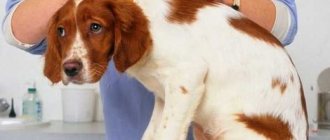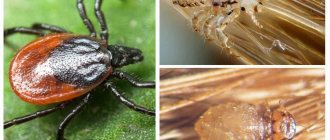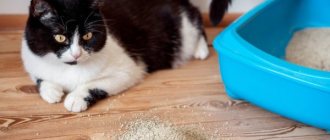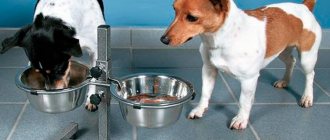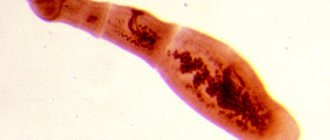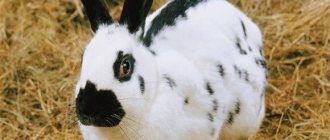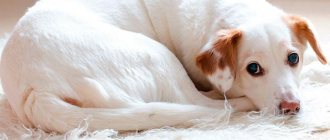Possible types of white stool in dogs
A preliminary diagnosis can be made by the color and consistency of feces. Some causes of stool lightening are completely harmless, so don’t panic ahead of time.
By shade
The noble chocolate color is the result of the work of bile, an important pigment involved in digestion. Its lack in the intestines leads to the lightening of excrement to:
- white-yellow;
- white-green;
- completely white, that is, colorless.
In the first case, there is a high probability of helminthic, tick-borne and viral invasion, as well as disturbances in the functioning of the pancreas. In the second case, it is worth checking the functioning of the gallbladder and making sure that the pet’s food does not contain dyes.
The third case is the most dangerous. Complete loss of color is typical for advanced pathologies, when the flow of bile is completely blocked. The animal must be shown to a veterinarian as soon as possible.
By consistency
Excessive dryness or excess moisture, turning feces into shapeless slurry, should alert the owner. Lightened pet stool can be:
- Liquid. Indicates disturbances in the functioning of the pancreas and liver. Sometimes it occurs due to improper feeding, which negatively affects the functioning of the gastrointestinal tract.
- Slimy. Characteristic of helminthiases and diseases of the colon, as well as an abundance of stringy meat in the diet.
- With a white coating while maintaining its shape or crumbly and hard. It occurs with an illiterate menu, replete with cartilage, veins and bones.
- With white splashes with a slight change in the main color. The grains, which resemble small grains, occur when infected with worms or due to digestive problems that impair the digestion of food.
The causes of dry and loose stools, as well as their lightening, can be harmless and pathological. In the first case, the owner can cope with the problem on his own, but in the second, he will have to contact a veterinarian.
What to feed a dog with white feces
If your dog's feces turn white due to some illness, you should pay special attention to its diet. First of all, the animal is stopped feeding fatty foods (pork with layers of fat, homemade cottage cheese and sour cream, etc.), offal and bones, strong broths, sweets, pasta, raw vegetables and fruits. Fried foods and smoked foods in the form of small sausages, sausages or frankfurters will also be prohibited. If the animal is accustomed to ready-made food, you should say a firm “no” to cheap store-bought pates and dry granulated products.
What can you feed a dog if it has white feces? The emphasis should be on boiled lean meat (chicken and turkey without skin, veal), porridge (oatmeal, buckwheat), boiled and pureed vegetables (carrots, zucchini), fresh and low-fat fermented milk products (cottage cheese, kefir). You can also give your dog porridge with fish or meat broth, but also low-fat. It is important to feed your pet in small portions, but often - up to 5-6 times a day.
Normal dog poop should be brown. Stool with blood or white color is a deviation, the explanation for which is important to find in a short time. Feces are stained with bile. It plays an important role in digestion. Sometimes the stool becomes yellow or very runny. In this case, the owner’s attentiveness and detailed diagnostics are required.
Safe reasons for lightening stool
If, apart from lightening, no other alarming symptoms are observed, then you can postpone contacting the veterinary clinic. In such cases, white feces in a dog are due to the following reasons:
- Regular consumption of bones. Eliminating these spicy and hard foods returns the usual consistency and color within a few days.
- Dehydration. This problem is common in animals that eat dry food. It takes much more liquid to digest it. When there is a lack of moisture, the body borrows reserves from its own cells, turning feces into a dry, crumbly substance.
- Long-term use of medications (Smecta, Augmentin) that affect liver function. After treatment is completed, the pet must take a course of lactobacilli to normalize lost functions.
- Excess animal fats in the diet. Pork, lard and dairy products with high fat content are poorly absorbed by the dog’s body, so veterinarians recommend excluding them from the diet.
If the suggested tips do not help, and your pet continues to defecate white feces, contact your veterinarian. Some pathologies occur in a latent form, so they can only be detected using laboratory diagnostics.
Pathologies requiring treatment
Since the liver is responsible for producing the usual color of excrement, most pathologies lie in it and adjacent organs: the gallbladder and pancreas. One of the most dangerous causes is a malignant neoplasm, which causes disruption in the functioning of the entire body.
Pathologies requiring treatment can be recognized by accompanying symptoms. If your pet is vomiting, feels weak and is not eating well, do not hesitate to get diagnosed. Without timely help, the disease can cause complications.
Liver diseases
Liver diseases are accompanied by lack of appetite, abdominal pain and bloating. During inflammatory processes, the animal's temperature rises. Most often diagnosed:
- hepatitis
– inflammation of hepatocytes (liver cells);
- fibrosis
– reversible excess formation of connective tissue on hepatocytes with loss of their functionality;
- cirrhosis
– an advanced form of fibrosis that is irreversible.
Delayed treatment of these pathologies can result in renal failure, glaucoma and acute toxicosis. The animal risks dying from anemia, internal bleeding or hepatic coma.
Gallbladder diseases
If the liver is responsible for the production of bile, then the gallbladder is responsible for its accumulation. Disturbances in this reservoir lead to the following diseases:
- cholecystitis - inflammation of the gallbladder, accompanied by fever and mucous vomiting;
- gallstone disease - an accumulation of stones or sand that injure the mucous membrane of the gallbladder;
- compression of the bile ducts.
If the stones completely block the ducts, then all the bile accumulates inside. Due to stagnation, urine changes color to bright orange. The mucous membranes turn yellow, and mucus and streaks of blood appear in the stool.
Pancreatitis
Inflammation of the pancreas makes it difficult to digest food. Food fragments are passed out along with feces, so some nutrients are not absorbed. Despite this, digestive enzymes continue to be produced. They accumulate in the pancreas and gradually digest it.
The disease is accompanied by vomiting, bloating and pain. The sick animal is depressed and refuses to eat, as attacks occur soon after feeding.
What does color say?
If your pet's stool has changed color, the first step is to find out the reason for this phenomenon. Only based on the results of diagnostic tests and examination of the dog, a veterinarian will be able to correctly diagnose and prescribe effective treatment.
The color of feces can already tell a specialist a lot about a possible problem. Let's look at what can cause stool to turn white or other unnatural colors.
White
White feces indicate that the dog is seriously ill. Moreover, the disease is already in an advanced stage. The lack of color in the feces indicates that bile has stopped flowing into the animal’s intestines.
The fact is that very often a white pile is a sign of developing oncology. Moreover, diagnosing cancer is difficult, since the search for a tumor is a long and complex process.
Yellow
If a dog has yellow, loose stools, various factors can lead to this disorder. Moreover, yellow feces can be either liquid or solid.
The appearance of solid waste is provoked by the following reasons:
- disturbances in the functioning of the pancreas;
- the presence of worms in the animal’s body;
- unbalanced and irrational nutrition.
Liquid yellow stool (diarrhea) is caused by the following reasons:
- intestinal infections (often viral in nature);
- problems with the pancreas;
- parvovirus infection;
- poor nutrition.
Related article: What ear diseases will permanently damage your dog's hearing?
In this case, the dog may defecate more than 3 times a day.
A change in the color of feces can be observed due to the fact that feces pass through the intestines very quickly and do not have time to be stained with stercobilin (a derivative of bilirubin). As a result, the digestion process is not completed. The color of the stool may also change to yellow if there is very little bilirubin (for example, hemolysis occurs - the breakdown of hemoglobin in red blood cells).
With blood
Sometimes dogs have feces mixed with blood. This can lead to bleeding, the source of which is located in the digestive tract. This is why dogs have blood in their stool.
By the color of the blood you can determine in which part the bleeding appeared:
- native blood (no changes, scarlet or red) - a problem in the distal gastrointestinal tract (large intestine, rectum, anal sphincter);
- in the form of “coffee grounds” - a disorder in the esophagus or initial sections, as well as in the stomach.
Loose, bloody stools can be caused by various diseases (for example, parvovirus enteritis, hemorrhagic gastroenteritis, etc.). Bloody diarrhea can also be caused by taking certain chemicals, drugs, or biological substances.
Black
If your dog has black stool (liquid or hard), this is a serious cause for concern. The appearance of such feces is provoked by the following factors:
- infestation of the animal with worms. In this case, the black (very dark) color of the feces will be diluted by blood clots;
- parvovirus enteritis (infectious disease). It often affects young dogs that have reduced immunity. In this case, blood is also detected in the stool;
- stomach ulcer. Accompanied by internal bleeding;
- hemorrhagic gastroenteritis (inflammation of the intestines or stomach). The disease often affects small indoor dogs.
The normal results of a dog’s life are colored brown. White feces in a dog is not a normal phenomenon, the explanation for which needs to be found in a short time.
Normally, feces are stained with bile, which plays an important role in a dog’s digestion. Bile is a very caustic substance, it helps to dissolve food in the small intestine, and unnecessary residues are eliminated from the dog's body naturally.
White feces in most cases indicate a pet’s illness, and its rather advanced stage.
. If the feces are not colored, we can conclude that bile does not enter the intestines. You should be wary if the feces have turned gray-white, light yellow, or become colorless, similar to mucus.
Unfortunately, almost all probable reasons (except for flaws in diet planning) are very disappointing. If you find that your pet's feces are not colored, you should not sound the alarm immediately, you need to observe a little. Monitor how your pet goes to the toilet to see if the feces have become too dry or textured (similar to compressed crumbs). You need to observe for 1-2 days, if no changes are noticed, consult a doctor.
Note!
In veterinary medicine, white stool in a dog is called acholic.
In addition to observing the color of the feces, it is recommended to analyze the dog’s behavior. The main attention should be paid to the diet and desires of the four-legged animal. If your pet reacts poorly to fatty broth or difficult-to-digest porridge, this is a sign that the liver is having a hard time coping with its functions. The fact is that bile is the body’s main weapon against fatty foods. If it is not excreted in sufficient quantities, the dog literally turns away from what it cannot digest.
The outflow of bile can be disrupted and restored naturally. For example, with dehydration, less bile is produced and the intensity of coloring of feces is also reduced. After poisoning, for example food poisoning, the liver takes some time to recover, which slows down the process of bile production. If you have no guesses about the reasons, you should consult a doctor to rule out:
- Liver pathologies, including a cyst
- a benign neoplasm that can compress or deform the liver.
- The presence of sand and stones in the gallbladder or ducts ()
- sand and stones clog the ducts, bile is produced, but does not enter the intestines. Against the background of this disease, there is a significant enlargement of the gallbladder and strangulation of the liver.
- – inflammation of the liver, including the viral type.
- (angiocholitis) and cholestatic syndrome - inflammation of the ducts and gallbladder.
- – destruction of liver cells.
- Liver fibrosis
is the degeneration of liver cells. Simply put, the necessary cells are replaced with fibrous ones (those that do not perform their functions).
- Compression or other deformation of the bile ducts
is a fairly rare occurrence in adult animals. If a puppy has congenital disorders, they are discovered in childhood or adolescence. In adult dogs, deformation of the bile ducts is never an independent disease, that is, the reason is another pathology that affects the liver and gall bladder.
- Benign tumors
in the liver or gall bladder.
Carrying out diagnostics
To determine the cause of the illness and the condition of the internal organs, the pet will have to undergo a comprehensive diagnosis. It includes the following research methods:
- stool analysis, which helps detect toxins or other dangerous substances;
- urine analysis to determine problems in the genitourinary system;
- a blood test necessary to detect deviations in baseline indicators;
- Ultrasound, detecting inflammation, neoplasms and stones;
- X-ray showing pathological changes in internal organs;
- liver biopsy, determining the presence of malignancy of the tumors found.
With timely treatment, all of these diseases can be treated. Even cirrhosis turns out to be reversible, but only at an early stage - when only a small part of the hepatocytes is damaged.
Solution
After diagnosis, the problem is eliminated by treating the found disease with medications or surgery. It is equally important to review the existing diet in order to reduce the load on the affected organs.
Treatment of diseases
Surgical intervention is used only in the most severe cases: gallstone disease and neoplasms. If the stones in the gallbladder are represented by sand, then it is removed with the help of special medications and a therapeutic diet.
It is also worth refusing surgery if there are metastases. Excision of the tumor in such cases carries many risks, so surgery is unjustified.
Inflammatory diseases are treated at home with the following medications:
- antibiotics (Trichopol, Trimethoprim, Cephalexin) that fight bacterial infections;
- choleretic (Allohol, Ursosan, Holosas), increasing the production of bile;
- antispasmodics (No-shpa, Baralgin, Papaverine), which relieve pain;
- hepatoprotectors (Covertal, Thiotriazolin, Hepatovet), restoring liver cells;
- enzymatic (Mezim, Creon), normalizing the natural microflora in the gastrointestinal tract.
Before recovery, you will have to undergo several tests to ensure the effectiveness of the therapy. Pets with growths that cannot be removed will need to visit the veterinarian regularly even after the condition improves.
Diet adjustments
When feeding naturally, fatty fermented milk products, smoked meats, lard, bones, pasta, as well as fruits and vegetables without heat treatment should be excluded from the diet. The new diet should consist of:
- boiled lean meat (chicken, turkey);
- boiled vegetables (zucchini, carrots);
- light meat and fish broths;
- watery cereals (buckwheat, oatmeal);
- fermented milk products (cottage cheese, yogurt, kefir) with low fat content.
If the animal eats dry food, then preference should be given to a medicinal line recommended for digestive problems, at least premium class. Cheap economy-class food should be avoided: they contain a lot of salts and sugars, and their nutritional value is not enough for proper nutrition.
Feeding should be fractional. Food is given 5-6 times a day in small portions. This supply eliminates the feeling of hunger, which is typical for too long breaks, and reduces the load on the gastrointestinal tract. Additionally, it is recommended to drink a decoction of chamomile. It has an antibacterial effect and cleanses the liver and gallbladder of toxins.
Diagnosis and treatment
It is important for the veterinarian to know what your dog ate in recent days, how he behaved, and whether he had contact with other dogs. Of course, if your pet has chronic diseases, this should also be reported to a veterinarian.
At the clinic, blood and urine samples will be taken from the dog, as it is vital to identify the root cause of the faeces turning into whitewash. In particular, with the development of liver pathologies, the amount of liver enzymes in the blood increases. To determine pancreatic diseases, the amount of insulin is determined. X-rays and ultrasound examinations of the abdominal cavity are helpful.
Your pet should be treated based on the initial disease leading to changes in stool. So, if there are stones in the gallbladder, it is advisable to perform an operation (especially in cases where its blockage has already developed). In milder situations, when the animal’s condition is not so severe, you can try to get rid of the stones using the technique of ultrasonic crushing. True, no one guarantees that the resulting sand will be able to escape into the intestinal lumen. Pancreatitis is treated using antibiotics (the disease often has an infectious etiology), as well as anti-inflammatory corticosteroids.
